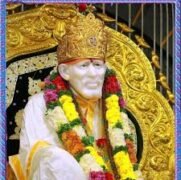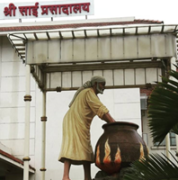By: D. Sankaraiah
 After Radhkrishnamai’s death, another staunch woman Sai devotee noted for vairagya (detachment) and selflessness Service took over performing similar services in Shirdi. Her name was Mrs. Jankibai Tample alias Shrimati Sai Mai (daughter of late Purushottam Sakharam alias Balasaheb Bhate. She admiringly filled up the gap created by the demise of
After Radhkrishnamai’s death, another staunch woman Sai devotee noted for vairagya (detachment) and selflessness Service took over performing similar services in Shirdi. Her name was Mrs. Jankibai Tample alias Shrimati Sai Mai (daughter of late Purushottam Sakharam alias Balasaheb Bhate. She admiringly filled up the gap created by the demise of Radhakrishnamai.
Radhakrishnamai.
She performed all the duties with wonderful zeal, promptness, and meticulous care worthy of admiration. She did all the services without even caring for her health.
She dedicated all her moveable and immovable property to the Sansthan by a deed settlement on 2nd January 1943. She also worked in the Sansthan as ‘Bhojanalay Sevika’ and discharged her duties with great enthusiasm and determination. She was found to be doing her work unmindful of her health, as she believed that the service to the Sansthan is the service to Baba. She also converted her office in Sansthan as “Bhojan Griha” (Dining Hall) which was exclusively meant for the benefit of devotees visiting Shirdi. This credit for managing the affairs of the Bhojan Griha goes to her. But for her strenuous efforts, it would not have been possible for the Sansthan to maintain any “Bhojan Griha.”
Mrs. Jankibai Tample used to recollect Padmasambhava, commonly known as Guru Rinpoche, who was a young, 8th-century Indian mystic who spent most of his adulthood in Tibet. His charm and enigma were such that he was revered and loved by everyone who met him except a handful of detractors. The king offered him a permanent place in his palace and treated him like a son. He was a bold speaker who spoke his truth fearlessly.
Legend has it that once while he would dance in ecstasy, holding the king’s ritual implements – a bell and trident – he hurled them into the air from his rooftop. They fell to the street below. The trident landed on the head of a passerby, killing him on the spot. Those who were jealous of him seized the opportunity and a propaganda war was launched. It worked and soon the public was outraged. His youth was termed as inexperience and his truth, arrogance. The locals pushed for the sentence that Rinpoche be banished from the community. He spent the rest of his life in the wilderness. That incident, however, was enough to awaken Rinpoche and bring him face to face with the reality of his world – impermanence.
 Wisdom often comes to us when our fortunes turn for the worse. Sometimes we only realize the value of things when we lose them. That is why Sri Narasimha Swamiji says, when you touch impermanence and meditate on death, this life is very beautiful. So, you must enjoy every moment of it. This was the mission in life for Shrimati Sai Mai.
Wisdom often comes to us when our fortunes turn for the worse. Sometimes we only realize the value of things when we lose them. That is why Sri Narasimha Swamiji says, when you touch impermanence and meditate on death, this life is very beautiful. So, you must enjoy every moment of it. This was the mission in life for Shrimati Sai Mai.
Realizing the impermanence of all things and all situations can fuel our passion for relishing and savoring all the wonderful parts of life. Positive experiences and situations can contribute to our overall contentment, but even more important, interior factors like an unjaundiced view of reality, good attitudes, and internal dispositions are crucial to experiencing real joy and happiness. Shrimati Sai Mai felt that when we accept that all things and situations in life are impermanent, we can cope better with change.
cope better with change.
Sri Narasimha Swamiji says in his book ‘Life of Sai Baba’ that when you are happy, remind yourself that this will not last. When you are sad, remind yourself that mindfulness will soothe your parched existence, because you become better able to balance your existence both in times of happiness and in times of sorrow.

Leave a Reply